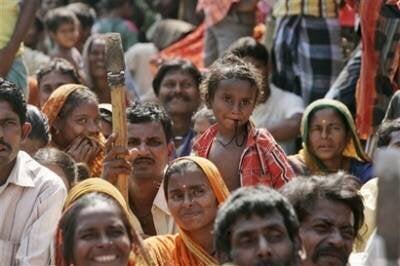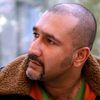
As a proud member of the Indian diaspora, I used to think that the world's largest democracy was also its most sophisticated. Now, I'm not so certain.
India just voted for its fifteenth Lok Sabha or "People's House." If there is anything to be learned from this largest exercise of franchise on the planet, the always-insular US media are certainly not interested in reporting it. Carrie Prejean's vacant mind gets more news time here. As an Indian Muslim and a former journalist who used to cover the heat and dust of this remarkable spectacle of democracy, a part of me is happy that the self-proclaimed standard bearer of "secularism" -- the Congress Party -- has defeated the Hindu nationalist and anti-Muslim BJP. But huge problems remain.
As always in India, it's about staggering numbers. 700 million of its 1.2 billion masses were eligible to vote and close to sixty percent did. Once again the world's largest middle class remained largely apathetic with the poorest of the poor in rural outposts voting with greater gusto. The Congress re-embraced its cause for the Aam Admi or Common Man. For the BJP in 2004, "India Shining" was the theme song. For the Congress, the Slumdog Millionaire anthem "Jai Ho" was seen as a better formula for success, with the entire nation gripped by the Oscars' finally deigning to acknowledge the bastardized Bollywood of that film, never mind if it was not an "Indian" film or had been accused of "poverty porn" by the intelligentsia.
India's frantic, disorganized and often elitist English-language media even dubbed Vote 2009 as Election 2.0, with hopes that Facebook and Orkut would Obama-ize their election as well. That was not to happen.
My home country and its politics are complex, to say the least. Many different Indias now jostle for space in the increasingly urban settings of air-conditioned shopping malls and the shantytowns and slums that surround them. Election time is perhaps the greatest equalizer. But dig deeper and you find that the dynastic politics of the subcontinent remain unchanged, for the most part.
The family you are born into makes all the difference at election time here but unlike Pakistan, where it turns into a kind of feudal chaos with no real democracy, India has had 15 successful elections since Independence or Partition in 1947. The newly elected caste of characters is as colorful as ever and includes mothers, fathers, sons and daughters in the highest numbers ever. Politics in India is a family business.
Among the hundreds of politicians braving the heat and dust of this vast nation in their air-conditioned Ambassador cars (this sturdy elephant of a vehicle has been synonymous with political power in India since 1957) were 38-year old Rahul Gandhi and his sister Priyanka, with the former whipping up a media frenzy every time he opened his dimpled mouth and was proclaimed India's Obama. Like Obama, Rahul is mixed-race. His Caucasian, Italian, Roman Catholic mother is today India's most powerful woman. In 2004 she was ridiculed for her roots and her accented Hindi (and English) but this widow of the "martyred" Rajiv Gandhi (a former prime minister) and daughter-in-law of the also assassinated Indira Gandhi, having already inherited the dynastic mantle of the President of the Congress, renounced prime minister-ship and gave it to a soft spoken Oxbridge-educated Sikh economist who had been credited with ending the socialist economic principles of previous regimes when he was a Finance Minister. Dr. Manmohan Singh, now 77, had never run for political office and was therefore not seen as a threat. Today, having held just one press conference in the last five years, he is seen as a stable, if puppet-like (with La Gandhi pulling the strings), alternative to the rantings of the Hindu nationalist BJP and often waxes eloquent about "secularism," seen by the Congress to be the very heart of the Indian nation state crafted after 1947.
It is no accident that in remarks to the Press right after the election results were announced, Singh rushed to thank Sonia and Rahul, grateful to them in a cloying way for his very existence. He takes all his orders from them, after all. The noisy and often hysterical television news channels had pundits claiming that Rahul would be anointed Prime Minister in as little as two years after Singh made him a Minister in his soon to be announced cabinet. It is hoped that in two years, at age 40, Rahul will have the sagacity for the highest office, apparently a birthright.
The media is also agog with the news of New York writer and former UN official Shashi Tharoor, who lost his bid for Secretary General, getting a cabinet post. Mr. Tharoor descended upon the state of Kerala, not speaking the language and appealing to the masses as Mr. Clean from someplace else. His patriotism rediscovered after a lifetime of living abroad, he now hopes to bring "Change." To his critics he is a firangi (a pejorative for "foreigner"), just like Madam Gandhi.
India is by no means a two-party system like the US, and this was the primary reason I used to attribute a superior democracy to it. But in 2009 many regional parties -- and there are more than a hundred -- have seen erosion in their support. The nouveau riche middle classes, however, are glad that the Communists, who had a strangled hold on the Singh 1 government, have been soundly defeated. Even the party of the downtrodden and "Dalits," the Bahujan Samaj Party (BSP) or Majority People's Party, have seen losses -- even though polls had predicted that its leader, a mostly uncouth woman called Mayawati, would have played kingmaker this time.
The keys to power are often given by India's largest state, Uttar Pradesh, the heart of the Hindi heartland and an often-accurate predictor of electoral tides. With a population equaling Brazil, UP this time was a surprise. The Congress here has made remarkable gains in areas where, much like the pre-Obama Democrats in the Bible-Belt states, it had given up all hope. For the first time in many years, it has 21 winners from here and is viable in the heartland again. It is unfortunate, though, that Uttar Pradesh ("UP" for short) is sending 31 MP's with criminal records to Parliament, which will now have an astounding 150 members who are also criminals. Above all, I remain conflicted to learn that the Muslims of UP, the most coveted voting block in that state, have voted predictably for the Congress, even though it is clear that they cannot vote for the BJP.
A quick look behind the numbers is instructive. The BSP fielded 14 Muslim candidates, two won. The second regional party, the Samajwadi Party (Socialist Party) fielded 12 and all lost. The Congress had the least Muslim representation on its ticket at 9, and only two won. The losers (the BSP and the SP) argue that the final vote share means a return of the Muslim vote to the Congress. Others say that the Muslim vote remains fragmented. For me, Muslims not voting for Muslim candidates presents an interesting phenomenon and the hold of dynasty (the Gandhi's) on the Muslim voters (like others) remains unchallenged.
BJP head honcho, LK Advani, the angry old man of an all encompassing "Hindutva" ideology is now 81-years old and much like the Republicans in the US, the BJP in India is floundering for a message beyond religious rhetoric to appeal to a forward looking, outsourced-and-loving-it population. His party amongst others is sending another Gandhi dynasty offspring Varun Gandhi to parliament. In prison recently for his hate speech, this young Gandhi said that the "Lotus" (symbol of the BJP) would "cut the head of Muslims".
In 2004, when the BJP was first defeated, I felt a sense of optimism. It was a vindication, I felt, for us Indian Muslims, massacred by a BJP government in the state of Gujarat in 2002. It was a remarkable moment indeed. A Sikh man (Manmohan) was anointed to power by a Roman Catholic woman (Sonia) and administered the oath of office by a Muslim President (APJ Abdul Kalam).
Now, as the circus of this prolonged election ends, I am not so sure. I know that Muslims remain a much-courted voting block and, at 13 percent, give India the world's third largest Muslim population. This year, more than two-dozen Muslim parties contested the election. Many said this was evidence of a fifty-year healing process after a bloody partition into a majority Hindu and majority Muslim nation. But Muslims remain India's most reviled minority, often in a state of poverty and illiteracy, and certainly the targets of "racial" profiling, ending up as prison majorities, much like African-Americans in the US prison system. The damning Sachar Commission report in 2006, initiated by the outgoing and now incoming Congress government, was seen as a way to identify the problems of the Indian Muslim. It did. But two years later, little has been done.
Ironically the loser BJP is already proclaiming that it "should have courted the Muslim vote" in Uttar Pradesh, where the largest Muslim populations live. How it could have done that is perplexing. Picture the Republicans trying to get pro-choicers to vote for them.
And these are only small symptoms in this land of a billion inequalities. The nation continues to obsess about certain "superpower status," which they see as only a matter of time to come. Poverty, dynasty and minorities be damned, they say. India has what China (and certainly the inconsequential Pakistan) do not. And that itself is a reason to celebrate.
